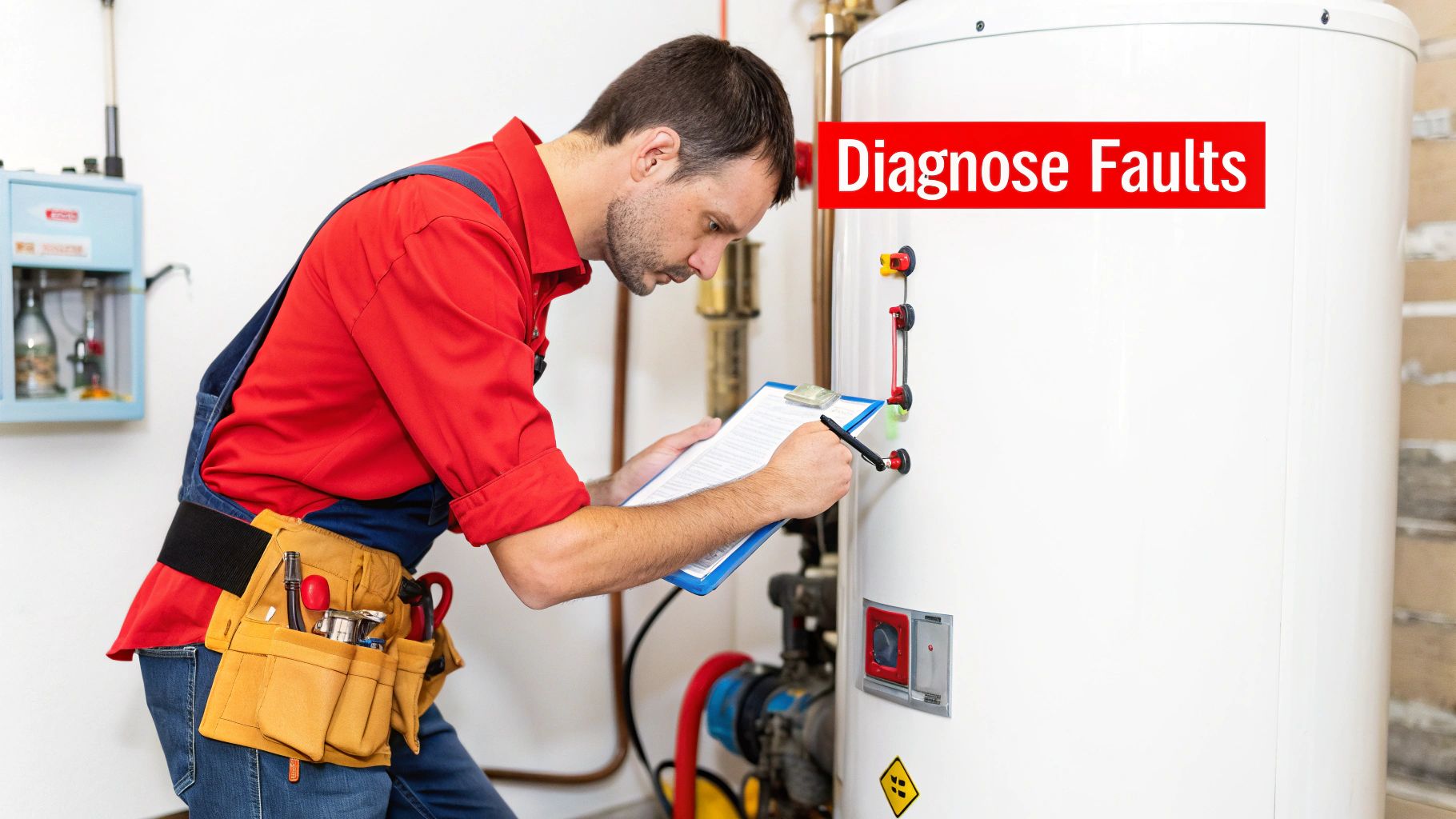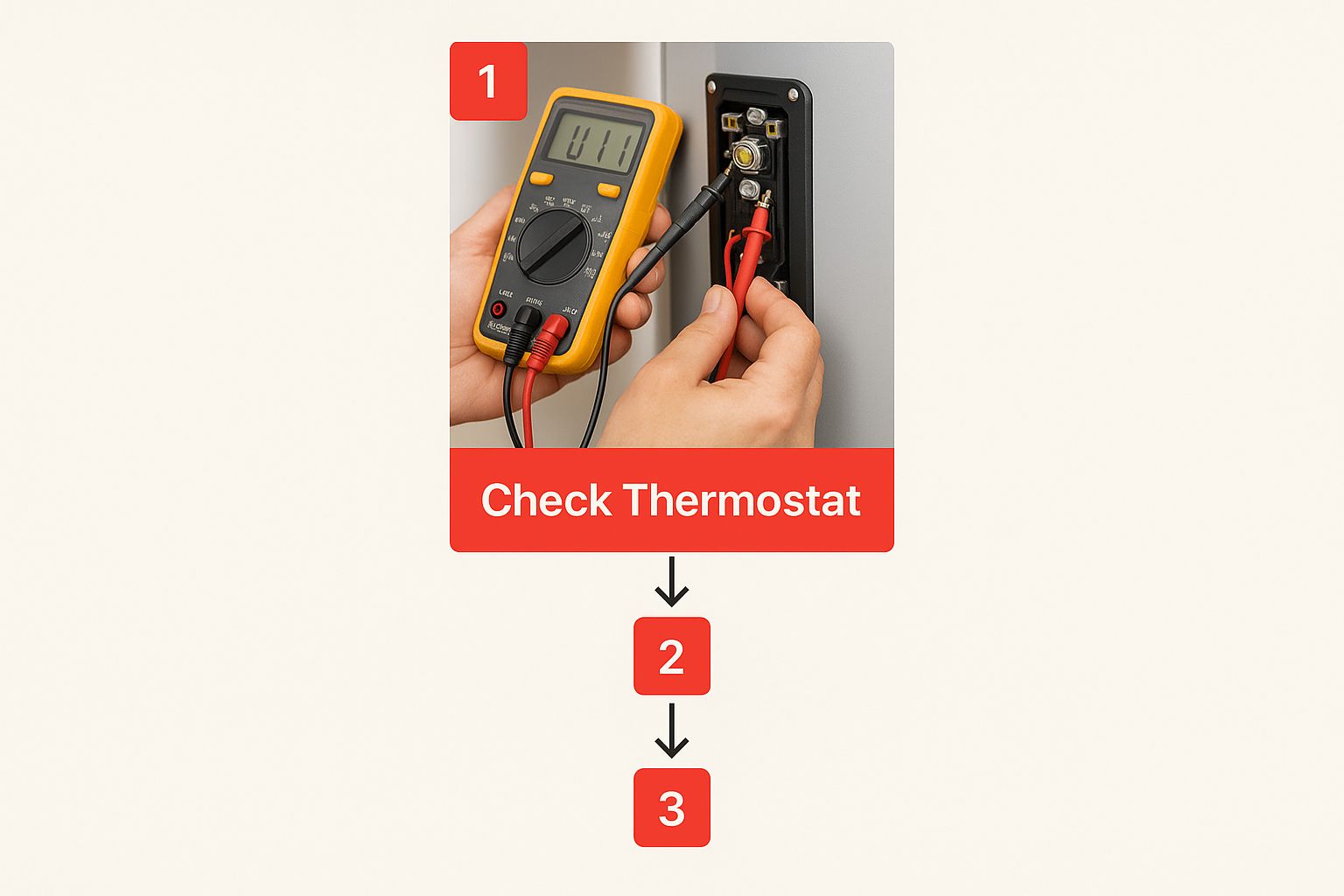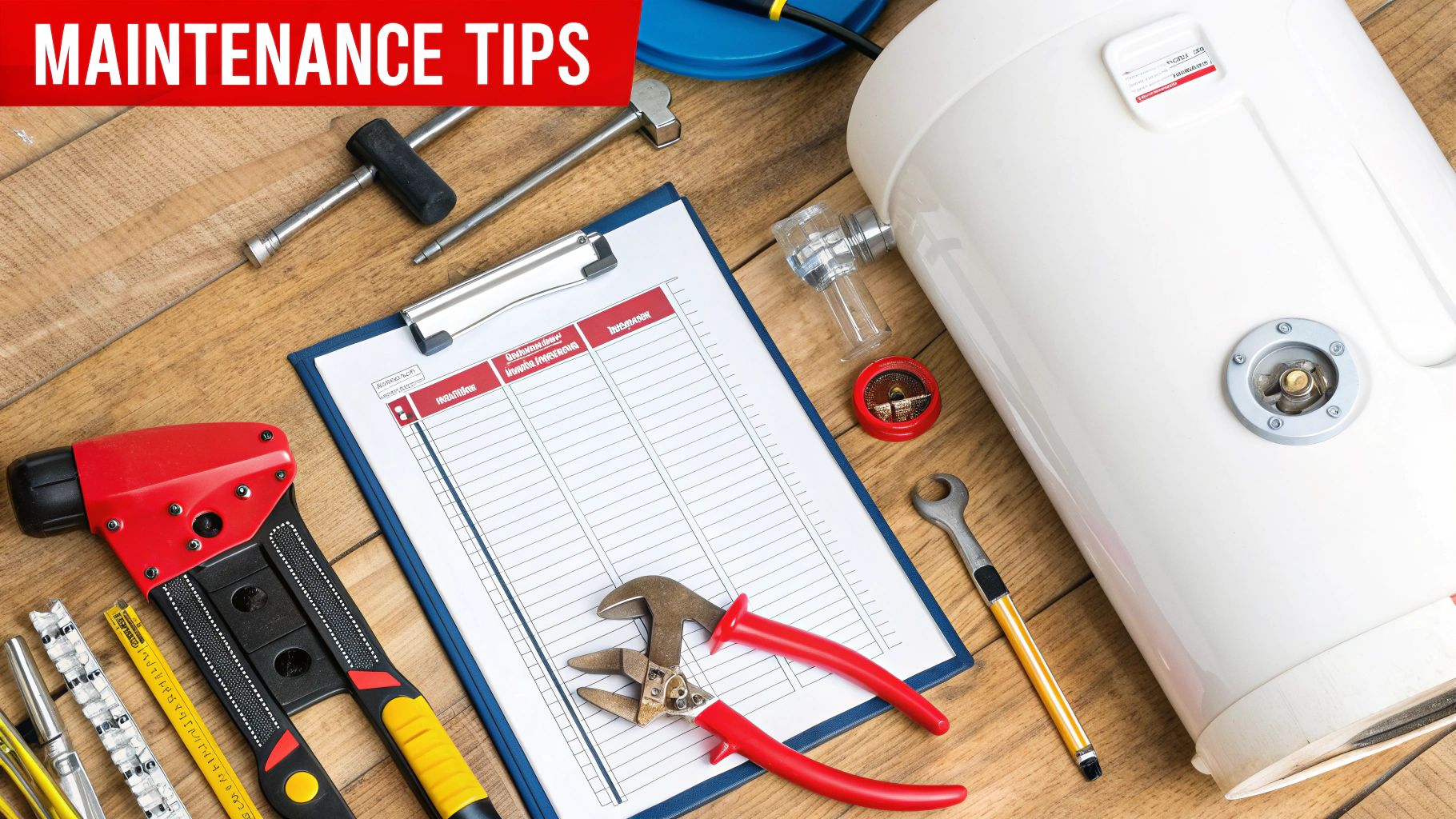That unexpected jolt of icy water during a hot shower is a rough way to start the day. When your water heater stops working, it doesn’t just interrupt your morning routine; it can bring your entire household or business to a standstill. The good news for residents in Oxnard is that effective hot water heater troubleshooting often starts with understanding the clues your system is giving you. Sometimes it's a minor adjustment, but other times it points to a deeper issue needing professional water heater repair.
Your First Steps for Hot Water Heater Troubleshooting

Before you assume the worst, take a moment. Based on our experience serving Ventura County, many common water heater problems have surprisingly simple solutions. This guide will walk you through diagnosing the issue so you can get back to your normal, warm routine.
Think of yourself as a detective investigating a problem. What exactly is happening? Is the water completely cold, or just lukewarm? Does the hot water run out far too quickly? Are you hearing strange noises from the closet, or have you noticed a puddle forming on the floor? Each symptom is a critical clue that points toward a specific culprit.
Identifying the Symptoms
Your water heater rarely fails without giving a few warning signs first. Learning to spot these red flags is one of the most valuable skills you can have as a homeowner. Let's break down the most common distress signals we see on service calls across the region.
-
No Hot Water at All: This is the most obvious sign of a problem. For an electric heater, it could be as simple as a tripped circuit breaker. On a gas model, the pilot light may have gone out.
-
Insufficient Hot Water: If your relaxing showers have become a race against the cold, something is wrong. This often indicates a failing thermostat, a broken dip tube mixing cold water into the tank, or a thick layer of sediment buildup reducing heating efficiency. We explore this in our guide on why you keep running out of hot water and how to fix it.
-
Strange Noises: Are you hearing popping, rumbling, or a high pitched whining sound? That's typically the sound of water struggling to heat through a layer of mineral sediment at the bottom of the tank. It’s a frequent issue in our area, but one that can cause overheating and serious damage if ignored.
-
Visible Leaks or Puddles: Finding water around the base of your heater is a major warning sign that requires immediate attention. It could be from a loose fitting or a pressure relief valve, but it could also signal that the tank itself has failed and you need an emergency plumber.
Taking a moment to observe what your water heater is doing, or not doing, can save you time and money. When you can accurately describe the symptoms to a professional, our team at Armor Hydro Jetting can diagnose the issue much faster and provide the right solution, whether it’s a simple pipe repair or a more complex fix.
This initial check helps you decide your next move. Is this something you can fix yourself, or is it time to call an expert for safe and effective service?
Common Water Heater Symptoms and What They Mean
| Symptom | What It Likely Means | Your Next Move |
|---|---|---|
| No hot water (Electric) | Tripped breaker, faulty heating element, or bad thermostat. | Check your circuit breaker first. If that’s not it, you’ll likely need professional component testing. |
| No hot water (Gas) | Extinguished pilot light or a thermocouple issue. | Carefully follow the manufacturer's instructions to re-light the pilot. If it won’t stay lit, call a professional. |
| Lukewarm water | A faulty thermostat, a broken dip tube, or crossed hot/cold connections. | Check the thermostat setting. If that's correct, an internal part likely needs replacing. |
| Rumbling/Popping noises | Significant sediment buildup on the bottom of the tank. | The tank needs to be flushed. While some try this DIY, a professional flush or hydro jetting is more thorough and effective. |
| Small puddles/Dripping | A leaking valve (T&P or drain valve) or a loose pipe connection. | Carefully inspect the connections and valves. Sometimes tightening a fitting is all that is needed. |
| Large pool of water | A major leak, very likely a corroded and failed tank. | Shut off the water and power/gas to the unit immediately and call for emergency plumbing service. |
Remember, this chart is a starting point for homeowners in Oxnard. While it covers the most common scenarios we encounter, every situation is unique. When in doubt, ensuring your safety is always the right call.
What to Check When You Have No Hot Water
Nothing disrupts your day faster than a shower that suddenly turns freezing. Your first thought might be a major, expensive problem. But before you panic and search for an emergency plumber in Ventura County, take a breath. Often, the solution is surprisingly straightforward.
A few quick checks can often restore your hot water in minutes. First, you need to know if your water heater is gas or electric, as the troubleshooting steps are completely different for each.
Is It Getting Power or Gas?
If you have an electric water heater, the problem is almost always power related. Locate your main circuit breaker panel and look for a large, double pole breaker labeled for the water heater. Has it tripped? If it is in the middle or flipped to 'off,' switch it completely off and then firmly back on. That might solve the problem.
Still no luck? Many electric heaters have a high temperature cutoff switch. It’s a small red reset button, often hidden behind an access panel on the side of the tank. Be sure to turn off the power at the breaker before you open that panel. A firm press of that button can often bring your heater back to life.
For those with a gas water heater, the first place to check is the pilot light. You will find a small access window at the bottom of the tank. Look inside; you should see a small, steady blue flame. If it’s out, you have found the issue.
Relighting the pilot is usually simple, but do not improvise. Follow the step by step instructions printed on the water heater's label. If you relight it and it goes out again after a few minutes, you are likely dealing with a faulty thermocouple, which is a job for a professional.
Check the Thermostat—It Happens!
You would be surprised how often this is the root of the problem. It sounds too simple, but thermostats get bumped or turned down by accident. Whether your unit is gas or electric, it has a temperature dial.
Take a look and make sure it is set where you want it. We generally recommend about 120°F for the perfect balance of heat and safety. Setting it any higher can create a serious scalding hazard, especially in homes with children.

On an electric heater, the thermostat is a common point of failure. If you are comfortable using one, a multimeter can tell you if the thermostat is sending power to the heating elements. If it is not, the elements cannot do their job. If you’ve tried these steps and are still having issues, or if the problem is that hot water just does not last, it is time to call for professional water heater repair.
Finding the Source of Leaks and Puddles

That sinking feeling you get when you spot a puddle of water around your water heater is something no homeowner wants to experience. While it is an immediate red flag, do not panic and assume the whole tank is failing.
More often than not, the leak is coming from a minor, fixable source. If you catch it early, you can often solve the problem without needing a new unit. Your first mission is to trace that water back to its origin. But first, prioritize safety, as water and electricity or gas are a dangerous combination.
Shut it Down: Your First Three Steps
- Go to your circuit breaker and turn off the power to the water heater if it is electric.
- If you have a gas model, find the gas supply line leading to the unit and turn the valve to the "off" position.
- Finally, shut off the cold water supply. You will usually find this valve on a pipe directly above the heater.
Once everything is safely shut down, you can start looking for the source of the leak.
Pinpointing the Leak's Origin
Use old towels to get the entire area around the heater completely dry, as it is much easier to spot a fresh drip on a dry surface. Now, let’s look at the usual suspects we find on service calls all over Oxnard.
- The Pipe Connections: Start at the top. Check the hot and cold water lines where they connect to the tank. These fittings can sometimes vibrate loose over time, and even a small, steady drip can create a large puddle.
- The T&P Valve: Look for the Temperature & Pressure (T&P) valve, which is usually on the side or top of the tank with a pipe running down toward the floor. If water is coming from here, the valve itself could be failing. Or, it could be doing its job and releasing water due to dangerously high pressure or temperature inside the tank, which is a serious issue.
- The Drain Valve: At the very bottom of the tank, you will find a spigot that looks like a hose bib. These are known for leaking. Sometimes they do not seal properly after being used, or the old washer inside simply fails.
Is It a Leak or Just Condensation?
Occasionally, what looks like a leak is just condensation. This is more common in colder weather when frigid water enters a warm tank, causing moisture to form on the outside. If you cannot find any active drips and the "puddle" is more of a damp spot that seems to come and go, condensation could be the cause.
However, if you trace the water back to the body of the tank itself, especially if it’s coming from the bottom seam, that is a bad sign. It almost always means internal corrosion has eaten through the tank wall. This is a problem that cannot be fixed; it requires a full replacement, and quickly.
When you cannot find the source, it is time to call in the experts. Our advanced leak detection services in Oxnard can find the exact origin of the problem without guesswork. Here at Armor Hydro Jetting, we have seen everything from a five minute fix to a complete tank failure. The key is to act fast at the first sign of water to save yourself from a much bigger flood and expensive water damage.
What's That Popping and Rumbling Sound?
Is your water heater suddenly making strange noises? If you are hearing pops, rumbles, or even a low growl, it is not just a sign of old age. It is a clear signal that something is wrong inside the tank.
Nine times out of ten, these sounds point directly to one culprit: sediment buildup. It’s a common problem we see all the time here in Ventura County, and it can cause serious issues if you ignore it.
The Problem Brewing in Your Tank
Our local water is full of natural minerals like calcium and magnesium. Over the years, these minerals slowly settle and create a hard, crusty layer at the bottom of your tank, right on top of the burner or heating element.
When the heater kicks on, it heats that sediment layer first. Small pockets of water trapped underneath flash boil into steam, forcing their way out with a "pop" or a "rumble." It is essentially a mini volcano going off in your utility closet.
That crusty layer does more than just make noise. It acts as a barrier, forcing your water heater to work much harder and longer to heat the water, which means higher energy bills. Even worse, the constant stress and overheating can weaken the steel tank, eventually leading to cracks, leaks, or even a complete tank failure.
Here’s an easy way to picture it: Imagine trying to boil a pot of water, but you’ve put a thick layer of rocks on the bottom. The burner has to run on high just to get the heat through the rocks, and the water underneath will bubble up erratically. That's exactly what's happening inside your tank.
The best defense is prevention; flushing your tank regularly can stop this buildup from getting out of hand. But if the sediment has already solidified, a simple flush will not be enough. That is when you might need a professional service like hydro jetting to blast the buildup away and get your heater running quietly and efficiently again.
Of course, not every sound is sediment. A high pitched whine could point to a restricted valve somewhere in your plumbing. Being able to describe the specific sound you are hearing helps a professional diagnose the issue much faster. We break down more of these scenarios in our guide to reliable water heater repair in Camarillo.
It is clear that keeping these units running well is important for homeowners. The residential water heater market is expected to jump from USD 29.9 billion in 2025 to USD 51.1 billion by 2035. Proper troubleshooting, like dealing with sediment that can slash efficiency by as much as 30%, is key to protecting your investment. You can find more data on the residential water heater market on futuremarketinsights.com.
When to Call a Professional Plumber in Oxnard
It is empowering to tackle basic hot water heater troubleshooting, but it is just as important to know your limits. Some problems are more than a simple DIY fix; they require professional attention. Trying to handle complex repairs without the right training and tools is not just risky, it can be dangerous.
For any homeowner in Oxnard, recognizing the difference between a small annoyance and a serious hazard is key to keeping your property and family safe. The goal is to fix the problem correctly, not accidentally create a bigger, more expensive issue.
Red Flags That Demand an Expert
Some issues should never be a DIY project. If you encounter any of these, your first step should be to safely shut down the unit, and your second should be to call for emergency plumbing help.
- You Smell Gas: This is a serious emergency. If you have a gas water heater and detect a "rotten egg" smell, you have a gas leak. Immediately shut off the gas supply line to the heater, evacuate the area, and call a professional.
- The Tank Itself is Leaking: A small drip from a valve or fitting can sometimes be managed. But if water is weeping from the main body of the tank, that’s a sign of internal corrosion and means the tank is on the verge of complete failure. It needs to be replaced by a licensed plumber, fast.
- Recurring Electrical Issues: If you have an electric model and the circuit breaker keeps tripping right after you reset it, stop. This indicates a serious underlying electrical fault, like a short in the wiring or a fried component, which is a major fire risk.
- A Malfunctioning T&P Valve: The temperature and pressure relief valve is your tank's most important safety feature. If it is constantly leaking or suddenly discharges a large amount of hot water, it’s signaling excessive pressure or heat inside. A faulty T&P valve could lead to a catastrophic tank rupture.
At Armor Hydro Jetting, we have seen many DIY repairs go wrong. Trying to save money on a gas line connection can lead to a dangerous leak, and improper wiring can permanently damage the unit. It’s simply never worth the risk to your safety or your home.
The Value of a Professional Diagnosis
Sometimes the problem is not an emergency, but a persistent issue you cannot solve. Maybe you have flushed the tank, but the rumbling noise continues. Or perhaps the water temperature is still inconsistent. This is when getting a professional diagnosis from a team like Armor Hydro Jetting is invaluable.
We use specialized diagnostic tools to pinpoint the real cause. It could be a stubborn sediment blockage that requires powerful hydro jetting, or it might be a failing gas valve. Our plumbers provide a range of services, including drain cleaning and comprehensive pipe repair, to address the root of the problem.
We will also give you an honest assessment. Sometimes it is a straightforward repair. Other times, we might have to explain that the cost of another repair is approaching the price of a new, more efficient unit, which is a wiser long term investment for your Ventura County home.
The global water heater market was valued at a staggering USD 30.49 billion in 2024 and is only expected to grow. This shows how essential these appliances are in our daily lives. As the technology becomes more complex, skilled maintenance is critical for troubleshooting everything from thermostat malfunctions to pressure valve failures and preventing energy waste. You can dive deeper into the growing water heater market on grandviewresearch.com. Bringing in an expert ensures your system is handled correctly.
Have Questions About Your Water Heater? We've Got Answers.
When your water heater acts up, many questions probably come to mind. As the plumbing team Ventura County trusts, we have heard them all. Let's get you some clear, straightforward answers so you can feel confident about what’s happening in your home.
How Often Should I Get My Water Heater Serviced?
Think of it like an oil change for your car. We cannot stress this enough: get your water heater professionally inspected and serviced at least once a year.
This is especially important for those of us living in Oxnard and the surrounding areas where our water is high in minerals, making sediment buildup a significant issue.
A yearly tune up is more than a quick inspection. It involves:
- Flushing the tank to remove efficiency robbing sediment. This also stops those annoying popping sounds.
- Checking the anode rod. This part sacrifices itself to corrosion so your tank does not rust from the inside out. We make sure it's still doing its job.
- Testing the T&P valve. This is a crucial safety component, and we ensure it works correctly.
This one preventative step is the best thing you can do to extend the life of your heater, keep it running efficiently, and avoid an unexpected cold shower.
Is It Time to Repair or Replace My Water Heater?
This is a common question, and the answer usually comes down to simple math and common sense. It’s probably time to consider a new unit if you are experiencing any of these scenarios:
- It's old. If your water heater is more than 10-12 years old, it is living on borrowed time.
- You're seeing rusty water. Discolored water is a major red flag that the inside of your tank is corroding.
- The tank itself is leaking. A leak from the main body of the tank is a fatal flaw that cannot be repaired.
- You need frequent repairs. If you are calling for water heater repair every few months, you are throwing good money after bad. Those bills add up and can easily surpass the cost of a new, reliable heater.
Our team at Armor Hydro Jetting can provide an honest, no pressure recommendation. We will help you compare the cost of a repair against the long term savings and peace of mind a new unit can bring.
Making the right call between repair and replacement can save you hundreds, if not thousands, of dollars. An older, inefficient unit might be costing you more in monthly energy bills than you realize, making a new model a smart investment for your property.
Why Does My Hot Water Disappear So Quickly?
A shower that goes from warm to cold in minutes is a common complaint. More often than not, the culprit is sediment buildup. It reduces the space available for hot water in your tank, making your 40-gallon tank perform like a 30-gallon one.
But that is not the only potential issue. A broken dip tube, which sends cold water to the bottom to be heated, can cause incoming cold water to mix instantly with hot water at the top. If you have an electric heater, one of the two heating elements could have burned out, meaning the unit cannot keep up with demand. And sometimes, the water heater is simply too small for your family's needs.
When you need clear answers and reliable solutions for your hot water heater problems, trust the local experts. For everything from routine maintenance and emergency plumbing to advanced drain cleaning, Armor Hydro Jetting is the reliable solution for homeowners and businesses in Ventura County. Visit our website to schedule your service.
